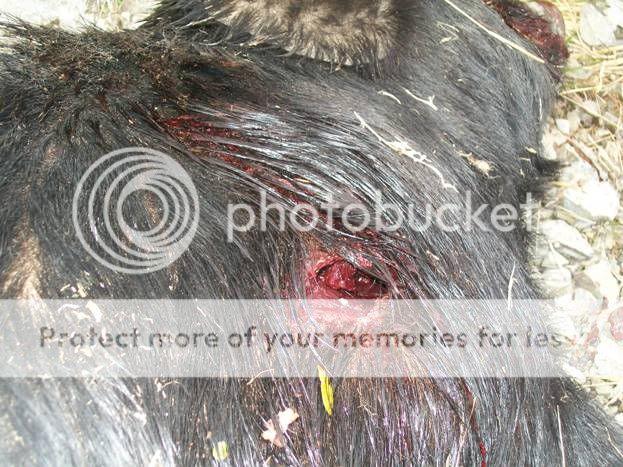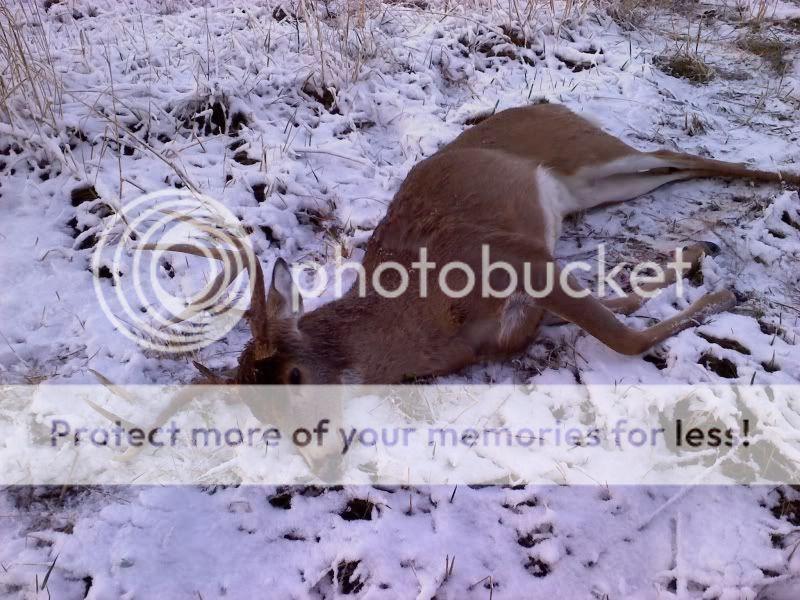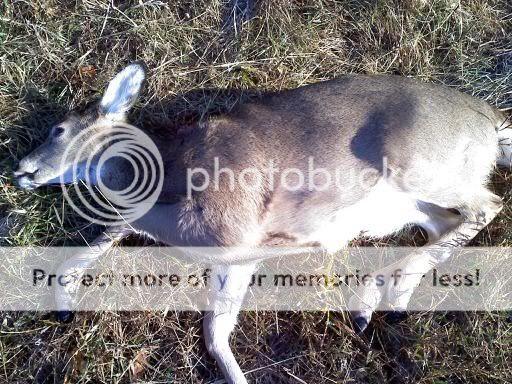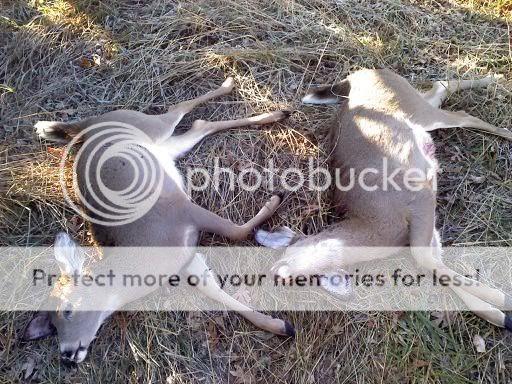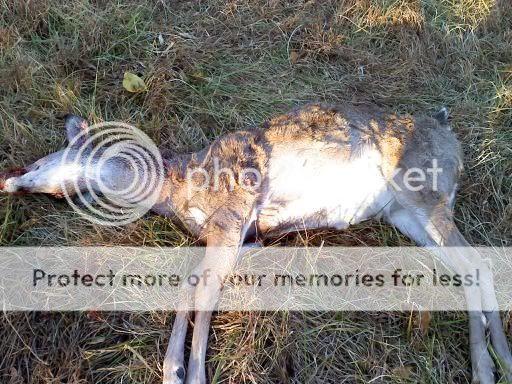So I finally had a chance to field test some of the 180 Berger's on something besides steel plates. Since I'm not longer a MT resident and I failed to draw a general combo tag I headed out with a few good buddies and an extra cow elk tag I was able to get after the drawing online.
The first animal we show with my gun a 7mm rem mag with a 26" Bison barrel shooting the 180 bergers @ 2840 fps was a 6 x 6 muley buck. He was bedded at 380 yards with no wind. So we set up and once he stood up my buddy Ashbee shot him through the neck and dropped him right back into his bed without the buck taking a step. The bullet passed right through the neck with about a 1 inch entry and exit hole so it wasn't that great to judge the performance of the bullet.
The second animal we took was my Cow Elk @ 415 yards with a 10 mph right to left crosswind. She was standing directly facing us so I took a head-on shot through her sternum. Instead of dropping in her tracks she just humped up did a 180 degree turn and slowing walked away about 30 yards then humped up and stood in place only offering a back end shot for a full 2 - 3 minutes before piling up. Upon opening her up we found a massive 6 inch wide entry hole into the chest cavity, but less damage than one would have expected to the lungs with such a massive entry hole into the chest cavity.
The third animal was a 6 x 6 Bull elk we found bedded alone in the timber across a canyon. My little brother decided that he wanted to take him so we crawled up to the top of the closest finger ridge across the canyon and set up @ 568 yards. There was a 3 mph crosswind. The bull was bedded quartering away behind a dead snag only offering us a low chest shot. It was my brothers first time firing my rifle so we got it dialed and then took about ten minutes for him to calm his nerves and talk about shot placement (or whether or not we should take the shot) and wind hold before taking the shot. I watched the the vapor trail from the first round smack the bull through the chest. He stood up in his bed and I told him to hit him again. I watched the second round take him through both lungs as he turned a quick 180 and then quartered the other way. He sent one more into the boiler room and it was all 4 hooves in the air for the bull. After a quick high 5 get hiked back to our horses and rode down to find our dad with another horse to go get the bull. While we were able to ride to within 300 yards of the elk it still took us about 45 minutes to hike up the 45 degree slope that he was on through the 3 feet of snow. We ended up boning out the bull where he was laying and found the the first round took him through the heart and passed completely through the chest leaving a massive exit hole. the second and third both quartering shots both caused trauma all the way to the far side of the hide, but neither exited.
Has anyone else had good or bad results with the 180 bergers? I'm kinda on the fence about trying a "more solid bullet" for black bears in May, but I'm not sure maybe the shot on the cow was just a fluke. I'm relatively new to the long range game with high BC bullets so any advice from the pros on this page will be greatly appreciated.
thanks,
syd
The first animal we show with my gun a 7mm rem mag with a 26" Bison barrel shooting the 180 bergers @ 2840 fps was a 6 x 6 muley buck. He was bedded at 380 yards with no wind. So we set up and once he stood up my buddy Ashbee shot him through the neck and dropped him right back into his bed without the buck taking a step. The bullet passed right through the neck with about a 1 inch entry and exit hole so it wasn't that great to judge the performance of the bullet.
The second animal we took was my Cow Elk @ 415 yards with a 10 mph right to left crosswind. She was standing directly facing us so I took a head-on shot through her sternum. Instead of dropping in her tracks she just humped up did a 180 degree turn and slowing walked away about 30 yards then humped up and stood in place only offering a back end shot for a full 2 - 3 minutes before piling up. Upon opening her up we found a massive 6 inch wide entry hole into the chest cavity, but less damage than one would have expected to the lungs with such a massive entry hole into the chest cavity.
The third animal was a 6 x 6 Bull elk we found bedded alone in the timber across a canyon. My little brother decided that he wanted to take him so we crawled up to the top of the closest finger ridge across the canyon and set up @ 568 yards. There was a 3 mph crosswind. The bull was bedded quartering away behind a dead snag only offering us a low chest shot. It was my brothers first time firing my rifle so we got it dialed and then took about ten minutes for him to calm his nerves and talk about shot placement (or whether or not we should take the shot) and wind hold before taking the shot. I watched the the vapor trail from the first round smack the bull through the chest. He stood up in his bed and I told him to hit him again. I watched the second round take him through both lungs as he turned a quick 180 and then quartered the other way. He sent one more into the boiler room and it was all 4 hooves in the air for the bull. After a quick high 5 get hiked back to our horses and rode down to find our dad with another horse to go get the bull. While we were able to ride to within 300 yards of the elk it still took us about 45 minutes to hike up the 45 degree slope that he was on through the 3 feet of snow. We ended up boning out the bull where he was laying and found the the first round took him through the heart and passed completely through the chest leaving a massive exit hole. the second and third both quartering shots both caused trauma all the way to the far side of the hide, but neither exited.
Has anyone else had good or bad results with the 180 bergers? I'm kinda on the fence about trying a "more solid bullet" for black bears in May, but I'm not sure maybe the shot on the cow was just a fluke. I'm relatively new to the long range game with high BC bullets so any advice from the pros on this page will be greatly appreciated.
thanks,
syd

